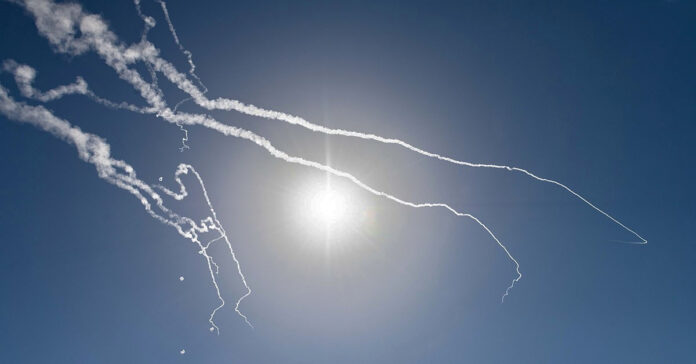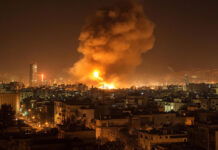Have you seen the video images of Iranians fleeing Tehran earlier this week? Cars crawl down the packed outbound lanes while very few zip towards the beleaguered city. A good example of why you should evacuate before the disaster rather than after. Or, in the case of a surprise bombing, leave immediately instead of waiting 24 hours.
But it isn’t only local civilians who are seeking to leave the city. Iranian officials are reportedly reaching out to Russia and friendly Gulf States looking for a place they can run to if it looks like the Iranian government will fall. That should give you an idea of how well the war is going for Iran.
The streets of Tehran are now empty, whereas life goes on pretty much as normal in Tel Aviv and the rest of Israel.
The question now is, will the U.S. get involved? If so, what will it mean for the country, the world, and those of us here in the States?
Iranian Threats
Iran has threatened to attack U.S. military bases in the Middle East if America gets involved in the war. But Iran has been threatening to destroy Israel for years and those threats have proven to be empty. Faced with a golden opportunity to do so, Iran is falling woefully short when it comes to destroying Israel, a country one tenth its size.
Like many belligerent people and governments, Iran talked a big game but is having a hard time putting points on the board. It reminds me of those perennial videos in which street fighters show up at a boxing gym and get their butts kicked. It’s easy to make threats and sound tough while others fight for you, but it is another thing entirely to know how to skillfully counterpunch. Like boxer Mike Tyson said, “Everyone has a plan until they get punched in the mouth.” Iran’s plan died when its air defenses and military leadership were taken out in a series of coordinated strikes.
How it Started
Whether or not Iran realizes it, they signed up for this when they allowed Hamas to go ahead with the October 7 attack on Israel. Look what has happened since:
- Israel gutted the Hamas leadership. Hamas has been rendered ineffective as a fighting force, and tens of thousands of Palestinians have been killed, many of whom were Hamas members or supporters.
- Hezbollah has been destroyed, their leadership demolished, and they have sat this war out. Lebanon is no longer a threat to Israel.
- Syria collapsed and the Assad regime is no more. Many of their tanks and other arms were destroyed or captured by Israeli as the country fell. Israeli jets can now fly over Syria because the country has no air force or effective air defenses. The U.S. has made early overtures of friendship to the new Syrian government.
- Russia has evacuated its military and naval bases in Syria, reducing its influence in the area. That puts one of Iran’s few remaining friends further away.
How it’s Going
Israel used the opening given to them by the Hamas attack to go on a multi-stage war that is gradually eliminating all of its enemies. Talk about playing 4D-chess!
Yesterday, Iran’s heavy water reactor was destroyed by Israel. It’s much-ballyhooed nuclear weapon program has suffered other significant blows. Their counterpunch has proven ineffective as they lost control of their air space. Much of their top leadership and intelligence officials have been killed, and what remains of its government is appealing to the United States to stop Israel’s attacks. (Oops, too late.) Now we hear Israel may have targeted Iranian Supreme Leader Ali Khamenei’s bunker.
Meanwhile, Russia is fuming because it has lost an ally and a source of drones and other munitions. China is angry because they have lost a source of cheap oil. Both are losing billions of dollars in investments. BRICS is losing a member. Terrorists are losing a state sponsor. The Palestinians are losing hope.
Israel is looking clever and strong.
What this Means
The war in Iran is also a stark reminder to the rest of the world of what happens when skillful adversaries armed with U.S. supplied weapons launch a large scale attack. For those who forgot the lesson the U.S. taught Iraq when it invaded Kuwait, they can see new pictures of precision munitions knocking out mobile missile launchers and before and after satellite pictures showing key targets. It’s a stark reminder to China that the U.S. has similar weapons designed to take out ships. China is reportedly studying the war in Ukraine for lessons. Watching this battle must be a reminder that Russia’s war is akin to two kids fighting on the playground compared to the sophistication of an air war with highly trained pilots and advanced fighter aircraft. And this is the JV; they haven’t even seen the varsity squad.
Meanwhile, the value of U.S. armaments just increased. The desire to have the U.S. as an ally jumped while the fear of having the U.S. as an enemy grew. Egypt, which has a massive army on the ground, is no doubt glad they reached peace with Israel decades ago. China is probably rolling that 2027 invasion date back a couple of years.
Unless Iran swallows its pride and unconditionally surrenders, allowing the U.S. full access to its nuclear program, I predict President Trump will bomb its deeply buried nuclear facilities. Such an attack is likely to be more than a few bunker busters; Trump, a president who knows the value of publicity and how to use the media, will no doubt launch a massive attack on multiple targets, complete with embedded reporters and plenty of video tape. If done properly, the result could reverse much of the damage done during the Afghanistan withdrawal and send a signal to both Russia and China.
Key Lessons
My strategic takeaways are:
One, anti-ballistic missile shields, such as Trump’s Golden Dome, can work, even though a few missiles slip by. Protecting Israel, a country the size of New Jersey, is far easier than protecting a country the size United States, but we could start by protecting key targets and expand from there.
Two, aerial drones are an effective and inexpensive way to attack your enemy. The U.S. has some sophisticated drones in our arsenal, and that’s good. However, I think we also need a few hundred thousand drones capable of carrying a 20 to 50-pound warhead. They would be like precision-guided artillery without the need for heavy launch devices.
Three, we need to keep working on drone interceptors and anti-drone technology, especially those that use lasers. Developing smaller drones designed to attack and destroyed large enemy drones is also an approach that should be explored. Anti-drone drones would be a good vehicle for some basic AI targeting software.
Four, let’s not ignore sea-based and land-based drones. I know our military has them, but as the technology progresses in the next decade, I might have one patrolling my land at night, responding to noises, communicating with me, and providing security.
Gas Prices Rising
In the past few days, our gasoline prices jumped 20 cents, but it is still under $3 a gallon. I filled up back when it was less than $3.60. With any luck, that will be the main effect those of us in the continental U.S. will see from a war in Iran. Well, that and too many angry speeches in Congress.
But just in case? It always pays to be prepared.







